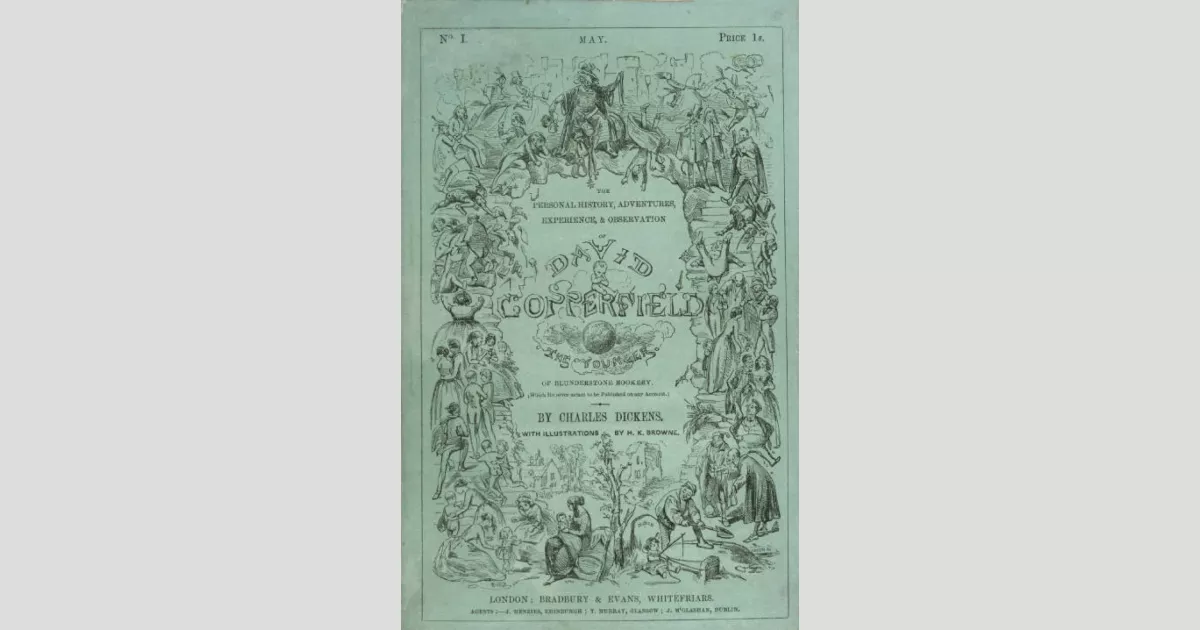David Copperfield, a bildungsroman by Charles Dickens, chronicles the life of its narrator, David Copperfield, from his childhood to adulthood. Published initially as a serial in 1849 and 1850, it was later released as a complete book in 1850. The novel follows David's adventures and personal growth as he navigates the complexities of life.
1900: Resurgence of Dickens' Popularity
Around 1900, Dickens' novels, including David Copperfield, experienced a surge in popularity.
1906: G.K. Chesterton's Defense of Dickens
G.K. Chesterton publishes his book, Charles Dickens, in 1906, in which he champions Dickens as a great English writer, offering a significant defense against the declining critical view of Dickens at the time.
1906: Popularity of Dickens' Characters
With millions of copies sold, characters from Dickens' novels, like Uriah Heep and Mr. Micawber from David Copperfield, became popular for use in merchandise like jigsaw puzzles and postcards.
1910: Expiration of Dickens' Copyrights
The 40-year copyrights for all but Dickens' latest novels expired, allowing other publishers in the UK to publish his works.
1911: Frank Reynolds Illustrates David Copperfield
Frank Reynolds created illustrations for a 1911 edition of David Copperfield.
1911: New Illustrations for David Copperfield
Fred Barnard and Frank Reynolds created new illustrations for different editions of Dickens' novels, including a 1911 edition of David Copperfield, showcasing different artistic styles.
1917: Franz Kafka's Inspiration for 'Amerika'
Franz Kafka notes in his diary that the opening chapter of his novel Amerika was inspired by David Copperfield, showcasing the novel's influence on other authors.
1936: Virginia Woolf's Re-reading of 'David Copperfield'
Virginia Woolf, despite her reservations about Dickens, acknowledges the power of David Copperfield, revealing in a letter that she is re-reading it for the sixth time and recognizing its enduring impact.
1940: Renewed Critical Interest in Dickens
Essays by George Orwell and Edmund Wilson, both published in 1940, contribute to a resurgence of interest in Dickens's works and their literary significance.
1941: Publication of 'The Dickens World'
Humphrey House publishes The Dickens World in 1941, further contributing to the growing critical appreciation of Dickens's literary contributions.
1948: F.R. Leavis' Initial Critique of Dickens
In The Great Tradition, F.R. Leavis criticizes Dickens as a popular entertainer lacking sophistication, excluding him from his canon of significant authors. This view would later be revised by Leavis.
1948: F.R. Leavis' Exclusion of Dickens from 'The Great Tradition'
In his influential work The Great Tradition, F.R. Leavis excludes Dickens from his canon of significant authors, categorizing him as a popular entertainer lacking depth and sophistication.
1954: Analysis of 'David Copperfield' as a Bildungsroman
Gwendolyn Needham's essay examines David Copperfield through the lens of the bildungsroman, a genre focused on the protagonist's personal growth and development.
1965: Recognition of 'David Copperfield's Centrality
K.J. Fielding identifies the centrality of David Copperfield within Dickens's body of work, emphasizing its significance in understanding the author's themes and development.
1965: Publication of Pilgrim Edition Begins
The Pilgrim edition of Dickens' letters, cited by recipient and date, began its publication. This edition spanned 12 volumes.
1966: Publication of Penguin Classics Edition
Trevor Blount's introduction to the 1966 Penguin Classics edition of David Copperfield, reissued in 1985, explores the novel's social commentary and the issues Dickens addresses through his fiction.
1968: Analysis of 'David Copperfield's Structure and Style
Sylvère Monod's analysis of David Copperfield highlights the novel's masterful structure and style, describing it as a triumph of Dickens's artistry.
1970: Leavises' Reassessment of Dickens
In Dickens the Novelist, F.R. and Q.D. Leavis revise their stance on Dickens, recognizing him as a major creative writer and acknowledging the depth and seriousness of his novels.
1976: Further Emphasis on the Novel's Centrality
Geoffrey Thurley echoes K.J. Fielding's view, highlighting the central importance of David Copperfield in Dickens's oeuvre and literary legacy.
1981: Exploration of Central Themes
Richard Dunne delves into the key themes of David Copperfield, including its autobiographical elements, the development of the narrator-hero, memory, and its connections to other Dickens novels.
1981: Publication of Clarendon Press Edition
The Clarendon Press published a reliable edition of David Copperfield with an introduction and notes by Nina Burgis, which became a reference for later editions.
1985: Reissue of Penguin Classics Edition
The 1966 Penguin Classics edition of David Copperfield, featuring Trevor Blount's introduction discussing the novel's social commentary, was reissued in 1985.
1987: Exploration of Dickens' Autobiographical Impulses
Alexander Welsh dedicates several chapters to analyzing David Copperfield as a culmination of Dickens's autobiographical exploration, reflecting on his own development as a writer.
2003: Completion of Pilgrim Edition
The Pilgrim edition of Dickens' letters, cited by recipient and date, was completed after 12 volumes.
2015: 'David Copperfield' Ranked Among Greatest British Novels
In a 2015 poll conducted by BBC Culture, critics rank David Copperfield as the eighth greatest British novel, recognizing its enduring impact and literary merit.
Trending

2 months ago Jamal Murray and Nikola Joki? discussed by David Adelman; Nuggets face Warriors and Suns.

8 months ago NBA Rescinds Doncic's Technical Foul After Lakers Star Blamed Ref's Error.
18 days ago Saddiq Bey Shines with High Scores and Impressive Highlights in Recent Games

Jeremiah Fears is an American basketball player He is currently playing college basketball for the Oklahoma Sooners in the Southeastern...

9 months ago Jordan Poole Claims Wizards Record, Surpassing Bradley Beal, After Rise From Teen

1 month ago Warriors' Commitment Questioned After Loss; Green, Butler Criticize Teammates; Curry's Reaction?
Popular

Candace Owens is an American conservative political commentator and author...

Tucker Carlson is an American conservative political commentator known for...

XXXTentacion born Jahseh Dwayne Ricardo Onfroy was a controversial yet...

Ilhan Omar is an American politician currently serving as the...

Kashyap Pramod Patel is an American lawyer who became the...

Frederick Christ Trump Sr - was an American real estate...

